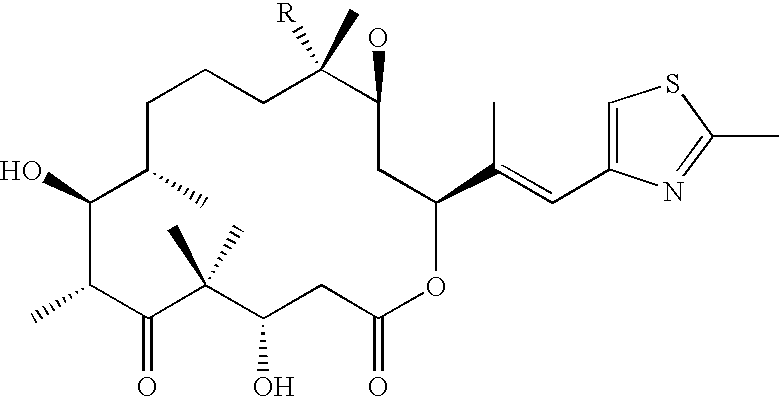Epothilone resistant cell lines
a cell line and epothilone technology, applied in the field of epothilone resistance cell lines, can solve the problems that the use of chemotherapeutic agents in this way is a major obstacle to the effective treatment of cancer, and achieve the effect of preventing epothilone resistan
- Summary
- Abstract
- Description
- Claims
- Application Information
AI Technical Summary
Benefits of technology
Problems solved by technology
Method used
Image
Examples
example 1
Generation of Epothilone A Resistant Cell Lines
[0105] Epothilone A resistant subclones of the parental MDA-MB-435 breast adenocarcinoma cell line are established according to methods described above. Specifically, MDA-MB-435 breast adenocarcinoma cells are incubated in MEM supplemented with 10% fetal calf serum in the presence of 10 nM of epothilone A at 37° C. under 5% CO2 for 5 weeks. Although the majority of the cells die, surviving clones are selected and further expanded in media containing 10 nM epothilone A. One out of 12 resistant colonies expanded well and is designated herein as the EA10 cell line. EA10 cells are maintained in media containing 10 nM epothilone A. Continued culture of the EA10 cells (founder cells) in higher concentrations of epothilone A yield additional, more highly resistant cell lines; cell lines resistant to 20 nM (EA20), 40 nM (EA40), 60 nM (EA60) or 150 nM (EA150) epothilone A are isolated in this manner.
example 2
Epothilone A Resistant Cells Overcome Epothilone A-Induced G2 / M Block
[0106] Cell cycle distribution patterns of epothilone A resistant and parental MDA-MB-435 epothilone A sensitive cells are compared by standard FACS analysis. Data indicate that the process of cell division in most of the MDA-MB-435 cells cultured for 24 hours in the presence of 20 nM epothilone A is blocked at the G2 / M phase of the cell cycle. In contrast, a large proportion of EA60 cells cultured for 24 hours in 60 nM epothilone A overcomes the G2 / M phase block and reenter G1 and S phases. Thus, a significant part of the epothilone A resistant cell population appears to overcome the G2 / M block that normally occurs in the cell cycle of epothilone A sensitive cells.
example 3
Two Potential Mechanisms of Resistance in Epothilone A Resistant Cells
[0107] The MTS assay is used to determine the concentration (IC50 ) of drug required to inhibit the growth of 50% MDA-MB-435, EA10, EA20, EA40, EA60, and EA150 cells. As shown in Table 1, the IC50 of epothilone A in EA10 and EA20 cells increases 5 fold and 7 fold respectively, over MDA-MB-435 cells. Interestingly, the IC50 of epothilone A is essentially the same in EA20 and EA40 cells, although EA40 cells are selected in double the concentration of epothilone A as is used to select EA20 cells. However, a 15 fold and a >100 fold increase in the IC50 of epothilone A in EA60 and EA150 cells, respectively, is observed. Furthermore, in contrast to the increasing resistance to epothilone A, EA40 and EA150 cells are equally resistant to TAXOL®. Thus, at least two potential mechanisms of epothilone A resistance may exist—a lower resistance mechanism that is cross-resistant to TAXOL® and a higher, epothilone A specific re...
PUM
| Property | Measurement | Unit |
|---|---|---|
| doubling time | aaaaa | aaaaa |
| volume | aaaaa | aaaaa |
| pH | aaaaa | aaaaa |
Abstract
Description
Claims
Application Information
 Login to View More
Login to View More - R&D
- Intellectual Property
- Life Sciences
- Materials
- Tech Scout
- Unparalleled Data Quality
- Higher Quality Content
- 60% Fewer Hallucinations
Browse by: Latest US Patents, China's latest patents, Technical Efficacy Thesaurus, Application Domain, Technology Topic, Popular Technical Reports.
© 2025 PatSnap. All rights reserved.Legal|Privacy policy|Modern Slavery Act Transparency Statement|Sitemap|About US| Contact US: help@patsnap.com

